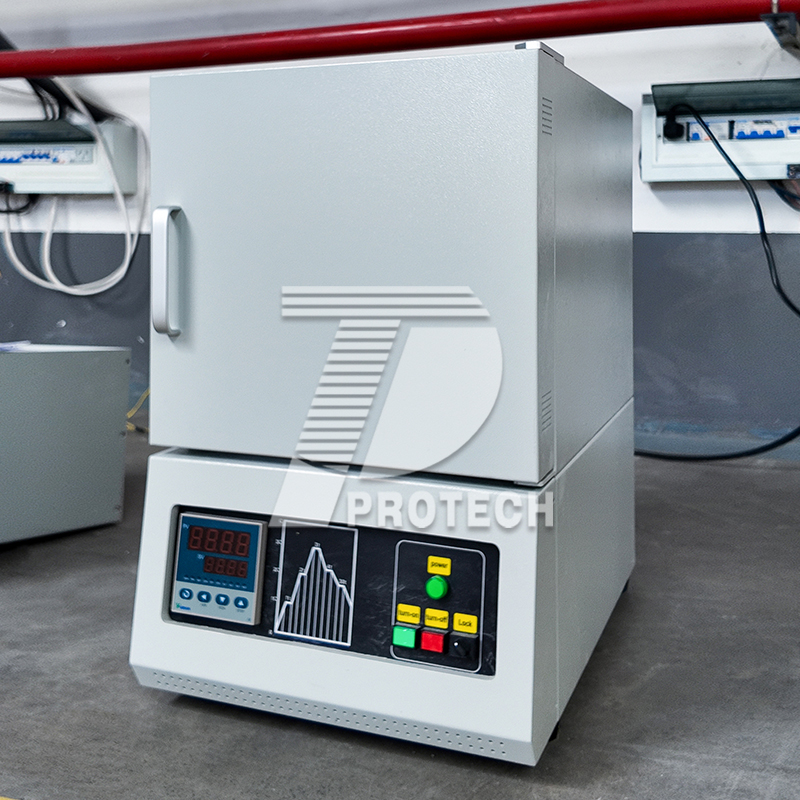As an experimenter or industrial producer, have you ever encountered material performance issues due to improper temperature settings? As a core heating device in laboratories and industrial production, the temperature curve configuration of a muffle furnace directly impacts experimental outcomes and product quality. This guide will help you comprehensively understand muffle furnace functions, application scenarios, and scientifically set temperature curves while avoiding operational errors.
QB7Muffle Furnace,Tube Furnace,Vacuum Furnace,Atmosphere Furnac
Protech muffle furnace
1. What Is a Muffle Furnace?QB7Muffle Furnace,Tube Furnace,Vacuum Furnace,Atmosphere Furnac
A muffle furnace (also known as a box-type resistance furnace) is a closed high-temperature device heated by electric elements. Its key features include excellent thermal insulation, uniform temperature distribution, and precise temperature control in air or specific atmospheres (typical range: 300°C–1800°C).QB7Muffle Furnace,Tube Furnace,Vacuum Furnace,Atmosphere Furnac
QB7Muffle Furnace,Tube Furnace,Vacuum Furnace,Atmosphere Furnac
Structure:QB7Muffle Furnace,Tube Furnace,Vacuum Furnace,Atmosphere Furnac
QB7Muffle Furnace,Tube Furnace,Vacuum Furnace,Atmosphere Furnac
Chamber (refractory materials)QB7Muffle Furnace,Tube Furnace,Vacuum Furnace,Atmosphere Furnac
QB7Muffle Furnace,Tube Furnace,Vacuum Furnace,Atmosphere Furnac
Heating elements (silicon carbide rods, resistance wires)QB7Muffle Furnace,Tube Furnace,Vacuum Furnace,Atmosphere Furnac
QB7Muffle Furnace,Tube Furnace,Vacuum Furnace,Atmosphere Furnac
Temperature control systemQB7Muffle Furnace,Tube Furnace,Vacuum Furnace,Atmosphere Furnac
QB7Muffle Furnace,Tube Furnace,Vacuum Furnace,Atmosphere Furnac
Safety protection devicesQB7Muffle Furnace,Tube Furnace,Vacuum Furnace,Atmosphere Furnac
QB7Muffle Furnace,Tube Furnace,Vacuum Furnace,Atmosphere Furnac
Advantages: Simple operation, stable temperature control, ideal for small-batch sample processing.QB7Muffle Furnace,Tube Furnace,Vacuum Furnace,Atmosphere Furnac
QB7Muffle Furnace,Tube Furnace,Vacuum Furnace,Atmosphere Furnac
2. Application ScenariosQB7Muffle Furnace,Tube Furnace,Vacuum Furnace,Atmosphere Furnac
Muffle furnaces serve as versatile tools across industries due to their precise temperature control:QB7Muffle Furnace,Tube Furnace,Vacuum Furnace,Atmosphere Furnac
QB7Muffle Furnace,Tube Furnace,Vacuum Furnace,Atmosphere Furnac
Materials Science: Ceramic sintering, metal annealing, glass melting.QB7Muffle Furnace,Tube Furnace,Vacuum Furnace,Atmosphere Furnac
QB7Muffle Furnace,Tube Furnace,Vacuum Furnace,Atmosphere Furnac
Chemical Industry: Catalyst activation, powder calcination, organic matter ashing.QB7Muffle Furnace,Tube Furnace,Vacuum Furnace,Atmosphere Furnac
QB7Muffle Furnace,Tube Furnace,Vacuum Furnace,Atmosphere Furnac
Laboratories: Heat treatment experiments in academic research and quality control.QB7Muffle Furnace,Tube Furnace,Vacuum Furnace,Atmosphere Furnac
QB7Muffle Furnace,Tube Furnace,Vacuum Furnace,Atmosphere Furnac
Ceramics Processing: Glaze firing, precision ceramic molding.QB7Muffle Furnace,Tube Furnace,Vacuum Furnace,Atmosphere Furnac
QB7Muffle Furnace,Tube Furnace,Vacuum Furnace,Atmosphere Furnac
3. Key Operational GuidelinesQB7Muffle Furnace,Tube Furnace,Vacuum Furnace,Atmosphere Furnac
Preheating & Program Setup:QB7Muffle Furnace,Tube Furnace,Vacuum Furnace,Atmosphere Furnac
QB7Muffle Furnace,Tube Furnace,Vacuum Furnace,Atmosphere Furnac
Preheat an empty furnace at low temperatures (first use) to eliminate moisture.QB7Muffle Furnace,Tube Furnace,Vacuum Furnace,Atmosphere Furnac
QB7Muffle Furnace,Tube Furnace,Vacuum Furnace,Atmosphere Furnac
Confirm program compatibility with experimental requirements before loading.QB7Muffle Furnace,Tube Furnace,Vacuum Furnace,Atmosphere Furnac
QB7Muffle Furnace,Tube Furnace,Vacuum Furnace,Atmosphere Furnac
Sample Placement:QB7Muffle Furnace,Tube Furnace,Vacuum Furnace,Atmosphere Furnac
QB7Muffle Furnace,Tube Furnace,Vacuum Furnace,Atmosphere Furnac
Use high-temperature-resistant crucibles or trays.QB7Muffle Furnace,Tube Furnace,Vacuum Furnace,Atmosphere Furnac
QB7Muffle Furnace,Tube Furnace,Vacuum Furnace,Atmosphere Furnac
Fill ≤2/3 of the chamber volume to ensure thermal uniformity.QB7Muffle Furnace,Tube Furnace,Vacuum Furnace,Atmosphere Furnac
QB7Muffle Furnace,Tube Furnace,Vacuum Furnace,Atmosphere Furnac
Safety & Monitoring:QB7Muffle Furnace,Tube Furnace,Vacuum Furnace,Atmosphere Furnac
QB7Muffle Furnace,Tube Furnace,Vacuum Furnace,Atmosphere Furnac
Never exceed rated temperatures to prevent element damage.QB7Muffle Furnace,Tube Furnace,Vacuum Furnace,Atmosphere Furnac
QB7Muffle Furnace,Tube Furnace,Vacuum Furnace,Atmosphere Furnac
Monitor temperature controllers in real-time; shut down if anomalies occur.QB7Muffle Furnace,Tube Furnace,Vacuum Furnace,Atmosphere Furnac
QB7Muffle Furnace,Tube Furnace,Vacuum Furnace,Atmosphere Furnac
Maintenance:QB7Muffle Furnace,Tube Furnace,Vacuum Furnace,Atmosphere Furnac
QB7Muffle Furnace,Tube Furnace,Vacuum Furnace,Atmosphere Furnac
Open vents for volatile samples.QB7Muffle Furnace,Tube Furnace,Vacuum Furnace,Atmosphere Furnac
QB7Muffle Furnace,Tube Furnace,Vacuum Furnace,Atmosphere Furnac
Clean residue monthly and inspect heating elements.QB7Muffle Furnace,Tube Furnace,Vacuum Furnace,Atmosphere Furnac
QB7Muffle Furnace,Tube Furnace,Vacuum Furnace,Atmosphere Furnac
4. How to Set a Scientific Temperature CurveQB7Muffle Furnace,Tube Furnace,Vacuum Furnace,Atmosphere Furnac
The temperature curve acts as a "roadmap" for furnace operation. Adjust dynamically based on material properties and process goals:QB7Muffle Furnace,Tube Furnace,Vacuum Furnace,Atmosphere Furnac
QB7Muffle Furnace,Tube Furnace,Vacuum Furnace,Atmosphere Furnac
Step 1: Define Process RequirementsQB7Muffle Furnace,Tube Furnace,Vacuum Furnace,Atmosphere Furnac
QB7Muffle Furnace,Tube Furnace,Vacuum Furnace,Atmosphere Furnac
Material Type: Metals, ceramics, and polymers require distinct heating rates.QB7Muffle Furnace,Tube Furnace,Vacuum Furnace,Atmosphere Furnac
QB7Muffle Furnace,Tube Furnace,Vacuum Furnace,Atmosphere Furnac
Objective: Sintering, annealing, and ashing demand different temperature nodes.QB7Muffle Furnace,Tube Furnace,Vacuum Furnace,Atmosphere Furnac
QB7Muffle Furnace,Tube Furnace,Vacuum Furnace,Atmosphere Furnac
Sample Quantity: Reduce heating rates for large batches to minimize thermal gradients.QB7Muffle Furnace,Tube Furnace,Vacuum Furnace,Atmosphere Furnac
QB7Muffle Furnace,Tube Furnace,Vacuum Furnace,Atmosphere Furnac
Step 2: Configure Segmented CurvesQB7Muffle Furnace,Tube Furnace,Vacuum Furnace,Atmosphere Furnac
A typical curve includes heating, holding, and cooling phases:QB7Muffle Furnace,Tube Furnace,Vacuum Furnace,Atmosphere Furnac
QB7Muffle Furnace,Tube Furnace,Vacuum Furnace,Atmosphere Furnac
Heating Phase:QB7Muffle Furnace,Tube Furnace,Vacuum Furnace,Atmosphere Furnac
QB7Muffle Furnace,Tube Furnace,Vacuum Furnace,Atmosphere Furnac
Initial rate: 5–10°C/min to prevent thermal stress.QB7Muffle Furnace,Tube Furnace,Vacuum Furnace,Atmosphere Furnac
QB7Muffle Furnace,Tube Furnace,Vacuum Furnace,Atmosphere Furnac
Near target temperature (e.g., <50°C): Reduce to 1–5°C/min to avoid overshooting.QB7Muffle Furnace,Tube Furnace,Vacuum Furnace,Atmosphere Furnac
QB7Muffle Furnace,Tube Furnace,Vacuum Furnace,Atmosphere Furnac
Holding Phase:QB7Muffle Furnace,Tube Furnace,Vacuum Furnace,Atmosphere Furnac
QB7Muffle Furnace,Tube Furnace,Vacuum Furnace,Atmosphere Furnac
Duration: Match material reaction times (e.g., 2–4 hours for ceramic sintering).QB7Muffle Furnace,Tube Furnace,Vacuum Furnace,Atmosphere Furnac
QB7Muffle Furnace,Tube Furnace,Vacuum Furnace,Atmosphere Furnac
Enable PID self-tuning for ±1°C stability in high-precision experiments.QB7Muffle Furnace,Tube Furnace,Vacuum Furnace,Atmosphere Furnac
QB7Muffle Furnace,Tube Furnace,Vacuum Furnace,Atmosphere Furnac
Cooling Phase:QB7Muffle Furnace,Tube Furnace,Vacuum Furnace,Atmosphere Furnac
QB7Muffle Furnace,Tube Furnace,Vacuum Furnace,Atmosphere Furnac
Natural cooling: Turn off heating for non-critical cooling.QB7Muffle Furnace,Tube Furnace,Vacuum Furnace,Atmosphere Furnac
QB7Muffle Furnace,Tube Furnace,Vacuum Furnace,Atmosphere Furnac
Programmed cooling: Set rates (e.g., 3°C/min) to prevent deformation.QB7Muffle Furnace,Tube Furnace,Vacuum Furnace,Atmosphere Furnac
QB7Muffle Furnace,Tube Furnace,Vacuum Furnace,Atmosphere Furnac
Step 3: Validation & AdjustmentQB7Muffle Furnace,Tube Furnace,Vacuum Furnace,Atmosphere Furnac
QB7Muffle Furnace,Tube Furnace,Vacuum Furnace,Atmosphere Furnac
Test with blank samples to record deviations.QB7Muffle Furnace,Tube Furnace,Vacuum Furnace,Atmosphere Furnac
QB7Muffle Furnace,Tube Furnace,Vacuum Furnace,Atmosphere Furnac
Adjust heating rates or add protective gases (e.g., nitrogen) if issues arise.QB7Muffle Furnace,Tube Furnace,Vacuum Furnace,Atmosphere Furnac
QB7Muffle Furnace,Tube Furnace,Vacuum Furnace,Atmosphere Furnac
5. Case Study: Alumina Ceramic SinteringQB7Muffle Furnace,Tube Furnace,Vacuum Furnace,Atmosphere Furnac
Heating Phase:QB7Muffle Furnace,Tube Furnace,Vacuum Furnace,Atmosphere Furnac
QB7Muffle Furnace,Tube Furnace,Vacuum Furnace,Atmosphere Furnac
RT → 200°C at 5°C/min (remove moisture).QB7Muffle Furnace,Tube Furnace,Vacuum Furnace,Atmosphere Furnac
QB7Muffle Furnace,Tube Furnace,Vacuum Furnace,Atmosphere Furnac
200°C → 1400°C at 8°C/min.QB7Muffle Furnace,Tube Furnace,Vacuum Furnace,Atmosphere Furnac
QB7Muffle Furnace,Tube Furnace,Vacuum Furnace,Atmosphere Furnac
Holding Phase:QB7Muffle Furnace,Tube Furnace,Vacuum Furnace,Atmosphere Furnac
QB7Muffle Furnace,Tube Furnace,Vacuum Furnace,Atmosphere Furnac
1400°C for 2 hours (grain growth).QB7Muffle Furnace,Tube Furnace,Vacuum Furnace,Atmosphere Furnac
QB7Muffle Furnace,Tube Furnace,Vacuum Furnace,Atmosphere Furnac
Cooling Phase:QB7Muffle Furnace,Tube Furnace,Vacuum Furnace,Atmosphere Furnac
QB7Muffle Furnace,Tube Furnace,Vacuum Furnace,Atmosphere Furnac
1400°C → 800°C at 3°C/min, then natural cooling.QB7Muffle Furnace,Tube Furnace,Vacuum Furnace,Atmosphere Furnac
QB7Muffle Furnace,Tube Furnace,Vacuum Furnace,Atmosphere Furnac
6. Common Errors & SolutionsQB7Muffle Furnace,Tube Furnace,Vacuum Furnace,Atmosphere Furnac
Error 1: Excessive Heating RatesQB7Muffle Furnace,Tube Furnace,Vacuum Furnace,Atmosphere Furnac
QB7Muffle Furnace,Tube Furnace,Vacuum Furnace,Atmosphere Furnac
Issue: Thermal stress causes cracking/deformation.QB7Muffle Furnace,Tube Furnace,Vacuum Furnace,Atmosphere Furnac
QB7Muffle Furnace,Tube Furnace,Vacuum Furnace,Atmosphere Furnac
Fix: Stage heating (e.g., 5°C/min below 300°C; 8–10°C/min above 800°C).QB7Muffle Furnace,Tube Furnace,Vacuum Furnace,Atmosphere Furnac
QB7Muffle Furnace,Tube Furnace,Vacuum Furnace,Atmosphere Furnac
Error 2: Incorrect Holding ParametersQB7Muffle Furnace,Tube Furnace,Vacuum Furnace,Atmosphere Furnac
QB7Muffle Furnace,Tube Furnace,Vacuum Furnace,Atmosphere Furnac
Issue: Incomplete reactions or incorrect temperatures.QB7Muffle Furnace,Tube Furnace,Vacuum Furnace,Atmosphere Furnac
QB7Muffle Furnace,Tube Furnace,Vacuum Furnace,Atmosphere Furnac
Fix: Follow material-specific guidelines; validate with small samples.QB7Muffle Furnace,Tube Furnace,Vacuum Furnace,Atmosphere Furnac
QB7Muffle Furnace,Tube Furnace,Vacuum Furnace,Atmosphere Furnac
Error 3: Uncontrolled CoolingQB7Muffle Furnace,Tube Furnace,Vacuum Furnace,Atmosphere Furnac
QB7Muffle Furnace,Tube Furnace,Vacuum Furnace,Atmosphere Furnac
Issue: Brittle fractures or lattice defects.QB7Muffle Furnace,Tube Furnace,Vacuum Furnace,Atmosphere Furnac
QB7Muffle Furnace,Tube Furnace,Vacuum Furnace,Atmosphere Furnac
Fix: Programmed cooling (3–5°C/min) through phase-change ranges.QB7Muffle Furnace,Tube Furnace,Vacuum Furnace,Atmosphere Furnac
QB7Muffle Furnace,Tube Furnace,Vacuum Furnace,Atmosphere Furnac
Error 4: Neglecting Atmosphere ControlQB7Muffle Furnace,Tube Furnace,Vacuum Furnace,Atmosphere Furnac
QB7Muffle Furnace,Tube Furnace,Vacuum Furnace,Atmosphere Furnac
Issue: Oxidation or volatile contamination.QB7Muffle Furnace,Tube Furnace,Vacuum Furnace,Atmosphere Furnac
QB7Muffle Furnace,Tube Furnace,Vacuum Furnace,Atmosphere Furnac
Fix: Use inert gases (N₂) for sensitive materials; open vents for volatiles.QB7Muffle Furnace,Tube Furnace,Vacuum Furnace,Atmosphere Furnac
QB7Muffle Furnace,Tube Furnace,Vacuum Furnace,Atmosphere Furnac
Error 5: Skipping CalibrationQB7Muffle Furnace,Tube Furnace,Vacuum Furnace,Atmosphere Furnac
QB7Muffle Furnace,Tube Furnace,Vacuum Furnace,Atmosphere Furnac
Issue: Temperature deviations >10°C.QB7Muffle Furnace,Tube Furnace,Vacuum Furnace,Atmosphere Furnac
QB7Muffle Furnace,Tube Furnace,Vacuum Furnace,Atmosphere Furnac
Fix: Calibrate every 3–6 months; verify uniformity with multi-point thermocouples.QB7Muffle Furnace,Tube Furnace,Vacuum Furnace,Atmosphere Furnac
QB7Muffle Furnace,Tube Furnace,Vacuum Furnace,Atmosphere Furnac
7. Advanced TechniquesQB7Muffle Furnace,Tube Furnace,Vacuum Furnace,Atmosphere Furnac
PID Self-Tuning: Automate parameter optimization for reduced human error.QB7Muffle Furnace,Tube Furnace,Vacuum Furnace,Atmosphere Furnac
QB7Muffle Furnace,Tube Furnace,Vacuum Furnace,Atmosphere Furnac
Data Logging: Export curves to compare experiments and refine parameters.QB7Muffle Furnace,Tube Furnace,Vacuum Furnace,Atmosphere Furnac
QB7Muffle Furnace,Tube Furnace,Vacuum Furnace,Atmosphere Furnac
Multi-Program Storage: Save presets (e.g., "Ceramic Sintering Mode") for efficiency.QB7Muffle Furnace,Tube Furnace,Vacuum Furnace,Atmosphere Furnac
QB7Muffle Furnace,Tube Furnace,Vacuum Furnace,Atmosphere Furnac
Pro Tip: Modern furnaces (e.g., Protech Technology models) feature touchscreen controllers, remote operation, and traceable data for streamlined workflows.QB7Muffle Furnace,Tube Furnace,Vacuum Furnace,Atmosphere Furnac
QB7Muffle Furnace,Tube Furnace,Vacuum Furnace,Atmosphere Furnac
ConclusionQB7Muffle Furnace,Tube Furnace,Vacuum Furnace,Atmosphere Furnac
Mastering muffle furnace temperature curves unlocks consistent experimental and industrial results. Whether for R&D or production, scientific temperature control ensures efficiency and quality. For further assistance with equipment selection or parameter optimization, consult our expert team for tailored solutions!




